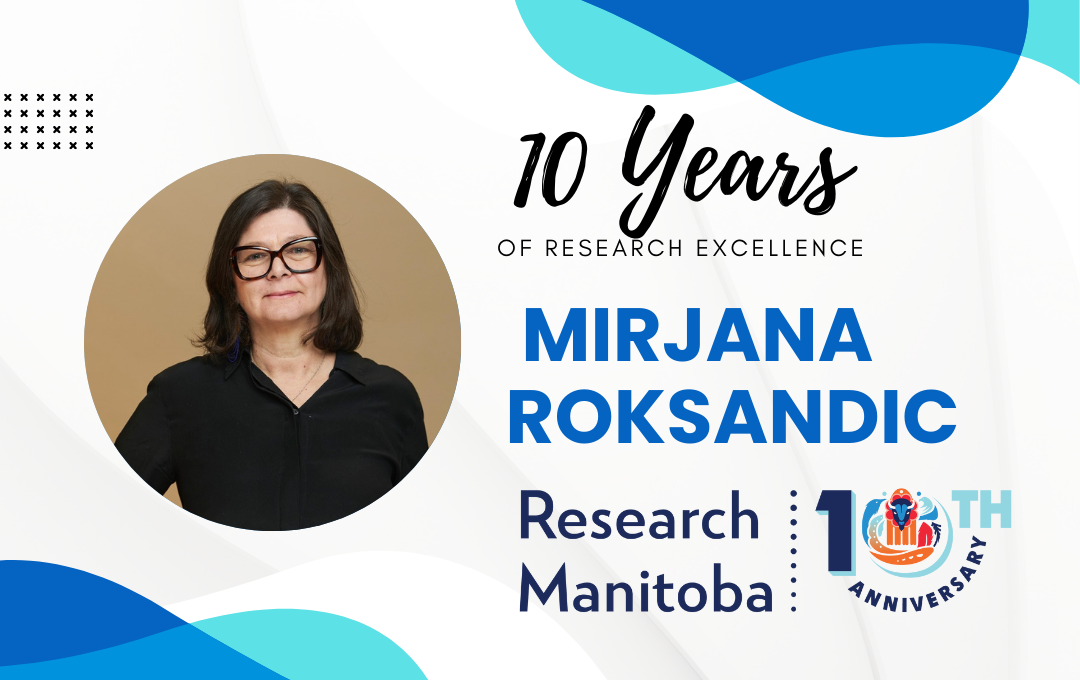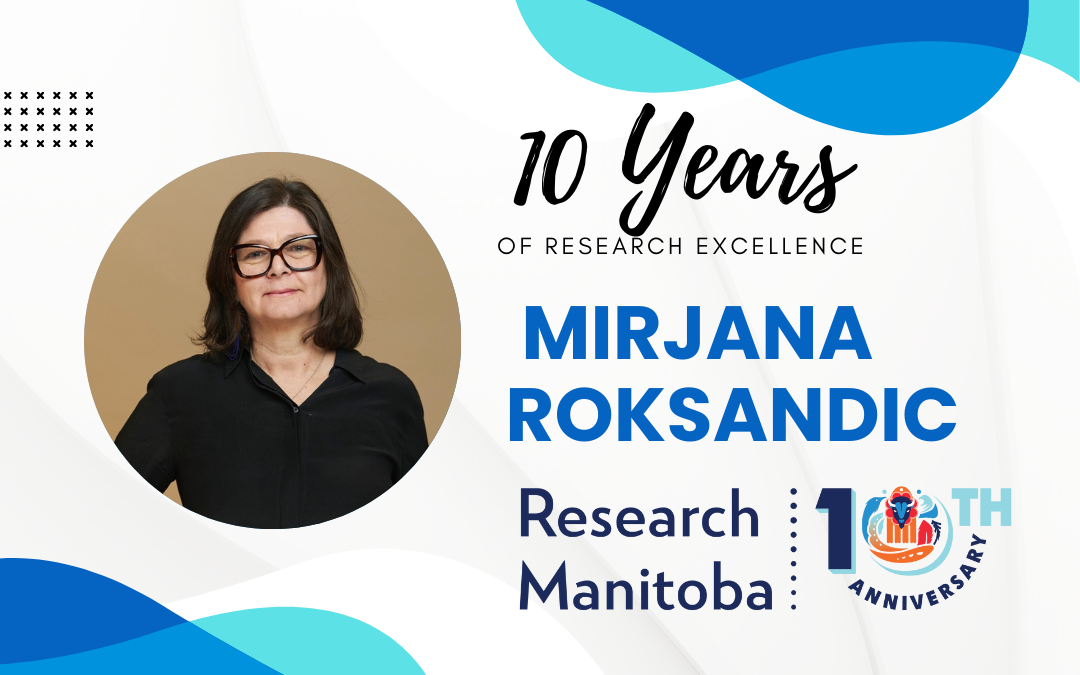
Throughout 2024-2025, Research Manitoba celebrates our 10th anniversary year. As we mark this achievement, we will be looking back at some of our past funded researchers to highlight their success.
Breaking new ground:
University of Winnipeg anthropologist’s work in the Balkans is helping to shed new light on the story of human evolution.
Profile written by: Brian Cole
Who are we and how did we get here? When it comes right down to it, that is the basic question Mirjana Roksandic has been trying to answer for nearly 40 years. And, as it turns out, she has made some noteworthy progress.
It all started when Roksandic was attending high school in Belgrade, Serbia, in the 1980s. “I was originally trained as a museum conservator in high school, believe it or not, and went to my first archeological dig to reconstruct pottery for the museum,” she says. In the years that followed, Roksandic studied archeology and anthropology at the University of Belgrade, the University of Bordeaux and Simon Fraser University. In 2004, she took a position as an assistant professor of anthropology at the University of Toronto before accepting a similar position at the University of Winnipeg in 2007.
In the years that followed, Roksandic studied archeology and anthropology at the University of Belgrade, the University of Bordeaux and Simon Fraser University. In 2004, she took a position as an assistant professor of anthropology at the University of Toronto before accepting a similar position at the University of Winnipeg in 2007.
Now, a professor of anthropology and coordinator of the bioanthropology program at the University of Winnipeg, Roksandic, spends much of her time studying and researching the evolution of hominins (humans and their ancestors).
“We (bioanthropologists) look at human remains to try to figure out how human society worked in the past,” Roksandic says. “The questions are social science questions. But the methods are biological science,”.
To that end, Roksandic is currently leading three projects all focused on movement and interaction among different human groups in the past.
One focuses on the hominin evolution and Paleolithic archaeology in the Eastern Mediterranean (Balkans and Anatolia) during the Pleistocene epoch (2.5 million years to 12,000 years ago); another examines hominin evolution during the Middle Pleistocene (780,000 to 124,000 years ago) in east Africa (Tanzania); and the third looks at mortuary practices and rituals in Nicaragua and Cuba among hunter-gatherers at the much later time.
The first two projects have shed light on the shared history of humans and their ancestors at a time when hominins were starting to develop the traits of modern humans, including a larger and more complex brain, smaller teeth, and smaller gut, and more complex social organization.
The Caribbean project, now led by Dr. Yadira Chinique de Armas, Roksandic’s colleague at the University of Winnipeg, has produced remarkable results in understanding the earliest peopling of the Caribbean islands and the connection between Cuba, Puerto Rico and Jamaica and the continental coastal areas of Central and South America during mid-Holocene (the current geological epoch that started about 12,000 years ago). However, it is the project in the Balkans that has the higher profile, in part because the work carried out by Roksandic, and her colleagues has raised some interesting questions about the human evolutionary timeline in that part of the world.
The project itself can be traced back to the early 1990s when Roksandic and fellow student Dušan Mihailović were attending the University of Belgrade. At the time, the two would often talk about teaming up one day to carry out a large dig in the Balkans – a mountainous region in southeastern Europe that takes in several countries, including Serbia, Bosnia and Macedonia.
Eventually, they would head off in different directions – Roksandic pursued her career in Canada, while Mihailović would eventually become a professor in the Department of Archeology at the University of Belgrade. But the dream of working together on a major dig in the Balkans never faded, largely because despite being a major migratory corridor for early humans – the Balkans link Western and eastern Europe with Africa and Asia – the region has never been fully explored.
As Roksandic noted in an article published in 2011, this could be because early researchers were more interested in the archaeological remains left behind by the Greek and Roman civilizations than they were in the older and less accessible artifacts of the Pleistocene epoch.
“This whole area has fascinating archeology, from medieval down to Neolithic,” says Roksandic. “But no one really cared about (the Paleolithic period) because it is so complicated to work on.”
In any case, the duo finally realized their dream in the early 2000s when they partnered with two other researchers to initiate a major project in the region. And it wouldn’t take long for the team to achieve success.
In 2006, the group, which included 20 students, unearthed a jawbone in the Mala Balancia cave, located about 200 kilometers southeast of Belgrade, Serbia. Following two years of testing and analysis, the mandible, including three teeth, was confirmed to be at least 500,000 years old – the oldest fossil ever to be found in the Balkans, and one of the oldest ever discovered in Europe.
Until recently, it had been widely believed that any remains dating back to the Pleistocene in the territory we now call Europe would likely belong to Neanderthals, also known as Homo neanderthalensis.
But the piece of jawbone in question did not belong to a Neanderthal or to Homo erectus, a species of humans that migrated from Africa to Europe about 1.8 million years. Instead, all the evidence seemed to suggest that it belonged to a yet unidentified descendant of the latter, which would eventually give rise to Homo sapiens (modern humans).
Then in 2015, students from University of Belgrade and the University of Winnipeg working with the team came across a single tooth while digging in the Pešturina cave, not far from the Mala Balancia cave. Interestingly, this tooth, estimated to be about 100,000 years old, did belong to a Neanderthal.

University of Winnipeg bioanthropologist Mirjana Roksandic with team members at an excavation site in Turkiye.
More recently, since 2020, the team discovered another seven teeth in a third nearby cave at Velika Balancia. The teeth are believed to have belonged to at least one adult and one Neanderthal child and have been radiometrically dated to be about 300,000 years old.
The findings are important because they suggest that members of the H. neanderthalensis and H. sapiens lineages could have lived in the same general area, even if at different times. Given that recent studies have shown that small amounts of Neanderthal DNA can be found in all humans living outside of sub-Saharan Africa and some human DNA can be found in the fossils of Neanderthals, is it possible that Neanderthals and H. sapiens crossed paths in the Balkans at the same time?
Roksandic says that remains to be seen, but it does seem likely.
“These three sites are very close to each other, which allows us to look at population movement and contact between Europe (particularly southeastern Europe) and southwestern Asia (specifically at sites in Turkey and Israel),” says Roksandic, noting that researchers have determined that people living at that time in both regions used tools of similar style and purpose.
“Their close proximity gives us insight into human evolution (in the region) from before 500,000 years ago to about 20,000 years ago in a more or less uninterrupted sequence. We are actively reconstructing the environment and geography at these times, which will be then linked to economic practices of different groups and eventually set the stage for a more in-depth look at what happened in this crucial zone of contact between the three continents.”
Work on the research project, officially known as Movement, Interaction, Resilience, Adaptation: The complex role of the Central Balkans in the peopling of Europe in the Pleistocene, is continuing, thanks to funding totaling $4 million. That includes $2.5 million from the federal Social Sciences and Humanities Research Council, and $1.5 million from a number of different partners. In addition, Research Manitoba has contributed $75,000 toward the creation of a lab to analyze findings from the Caribbean and the Balkans, as well as grants for students working on both projects.
Roksandic’s impact in the field of bioanthropology is not limited to her work in the field. She is also part of a group endeavoring to revise the terminology used to classify various species of humans who lived during the Pleistocene epoch.
Paleoanthropologists use a system of classification called taxonomy to categorize our ancient ancestors. Over time, the ancestors of modern humans (Homo sapiens) have been classified by various names, or taxa, including Homo heidelbergensis and Homo rhodesiensis.
But in a paper for Evolutionary Anthropology published in 2021, Roksandic and her colleagues argued that these labels have outgrown their usefulness. Instead, the authors recommended that H. heidelbergensis be restricted to its original specimen (a lower jaw discovered in Germany in 1907) and that H. rhodesiensis be discarded. They proposed a new species, Homo bodoensis, be used to refer to the fossils of hominins that emerged in Africa in the Early Pleistocene and gave rise to modern humans (H. sapiens) around 350,000 years ago. They also could have migrated as far west as Southeast Europe by the Middle Pleistocene – an important time in human evolution.
“The Middle Pleistocene is increasingly recognized as a key time frame that witnessed the appearance, on a global scale, of two critical traits of later human morphology: greater encephalization (size or complexity of the brain) and smaller teeth, and likely the differentiation of geographic groups,” they wrote.
“Newly defined (H. bodoensis,) cuts through the obfuscating and inconsistent use of improperly named and defined Middle Pleistocene hominins in Europe and Africa and should facilitate more consistent and meaningful discussions around these various topics presented here,” the authors said.

“We (bioanthropologists) try to look at human remains to try to figure out how human society worked in the past. “The questions are social science questions. But the methods are biological science,” - Mirjana Roksandic, 2025.
Since that paper was published, Roksandic says H. bodoensis is being used more often to classify new fossil finds, although more discussion among anthropologists and archeologists will be needed to achieve professional consensus on the issue.
Prof. Mirjana Roksandic
University of Winnipeg
2019 CFI JELF Award.
Applicant: Mirjana Roksandic
Program: CFI JELF
Project Title: Movement, Interaction, Resilience, Adaptation (MIRA): Integrated laboratory for the study of human-environment interaction
Mirjana Roksandic is a Professor in the Department of Anthropology and coordinator of the interdisciplinary program in Bioanthropology at The University of Winnipeg and graduate faculty at the University of Manitoba. Her main research topics include Pleistocene hominin evolution in Europe and in particular Eastern Mediterranean and mortuary ritual among sedentary and semi-sedentary archaeological hunter-gatherers. She has two active international projects: one in Serbia focusing on hominins excavated in Paleolithic caves, and the other in Cuba and Nicaragua where she is working on questions of mortuary practice and ritual continuity in the Caribbean. She is interested in when, how, and why humans have moved across continents and vast expanses of lands and sea in the context of adaptation to climatic fluctuations and social pressures. Prof. Roksandic is a recipient of NSERC and SSHRC grants, and the recipient of the Nellie McClung Foundation Manitoba Women Trailblazer Award.

